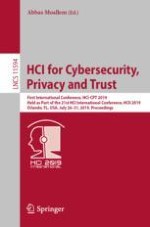2019 | OriginalPaper | Buchkapitel
Interdependencies, Conflicts and Trade-Offs Between Security and Usability: Why and How Should We Engineer Them?
verfasst von : Bilal Naqvi, Ahmed Seffah
Erschienen in: HCI for Cybersecurity, Privacy and Trust
Aktivieren Sie unsere intelligente Suche, um passende Fachinhalte oder Patente zu finden.
Wählen Sie Textabschnitte aus um mit Künstlicher Intelligenz passenden Patente zu finden. powered by
Markieren Sie Textabschnitte, um KI-gestützt weitere passende Inhalte zu finden. powered by
